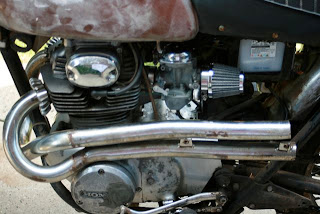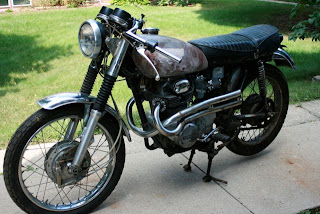Last Sunday Matt came over with the camera and all told I spent a solid six hours working on the bike. In the morning I extracted it from my Tetris-like garage arrangement, setup an improve workbench and went through the day’s work in my head.
Before Matt arrived I started out with a few small adjustments to the recently overhauled carburetors. I thought there was a more thorough procedure outlined in my Clymer manual but most of the adjustment requires the bike to be running so that will have to wait.
Since we’re going with individual “pod”-style air filters one of the tasks on today’s agenda is removing the existing airbox. This was pretty straightforward once I realized that the two sides of the box are connected to each other using a rod that goes between the two sides. After bending the rod and denting one side of the airbox I realized this, removed the nut from one end and the whole thing fell away nicely. This really opened things up under the seat and there is now a lot more room to work with (which will make mounting the carbs a lot easier) but there are a few brackets and tabs and such that I think can go, later.
Since I needed some pipe clamps (on the list for the Fleet Farm run when Matt arrives) to mount the carbs I decided to move on to something easy like swapping out the handlebars. The CL come with these cool MX-style bars but I have a pair of even-cooler clubman bars I bought for my Monster years back but they didn’t fit.
I sliced the left grip to remove it and the pulled the screws from the left-side controls. For some reason, they didn’t just fall off at that point. I attributed this to decades of goo but after moving it around a bit I realized something more discouraging: all of the electrical for the hand controls are threaded through the handlebars.
I took a minute to contemplate what this meant and came to a few conclusions. The first was that it was very unlikely that the current wiring would be of the proper length for the new bars, so I’d be looking at extending it. If I’m going to extend it, I want to cut it back to a point where I could add a water-tight connector and hide it away, so that means back by the speedometer and tach. It also means I’ll need the connector itself, the wire, some way to “wrap up” the individual leads and I’ll be re-wiring the controls as well.
I was just about to cut the first wire when I realized that if I started this process now there was little-to-no chance the bike would run today. I didn’t have any great expectations that it would run anyway, but if I dove into this re-wiring effort (which required parts I didn’t have on hand) that there would be little chance of having everything in place to try and fire up the engine.
So instead I grabbed the Simple Green and started scrubbing until Matt arrived.
When Matt got there we grabbed a couple of cups of Black Gold and I went over the plan. We headed to Fleet to pick up a new battery, hose clamps, air filters and a fuel filter.
We returned with some hose clamps, a fuel filter (for a lawn tractor) and a battery charger (mine had burned up recently and I thought for $25 it would be worth a shot to try and revive the battery). I threw the battery on the charger and started the re-assembly with the carburetors. With the airbox removed this went quickly and easily and with the newly-cleaned carbs the throttle action was much improved (although I still need to at least lubricate the cable if not replace it at some point).
Once that was done I realized that I still had to hang the pipes and as I got started with that Matt grabbed the camera and started rolling. It had been awhile since I played with mounting the exhaust but after a few botched attempts I remembered how the two-piece flanges went on and the pipes were back on the bike.
Since they are considerably shorter than before the mounts that previously supported them no longer make sense, so for the moment they are simply bolted to the head. I imagine this isn’t a long-term solution.
With the carbs back on and the pipes hung, we were ready to drop in the battery, apply fuel and attempt to fire up the engine. I checked on my old battery and according to the charger it was almost done (one remaining bar on the 5-bar charge indicator). Thinking optimistically I pulled the battery off the charger and dropped it in the bike; there was almost no response. Realizing this was futile I pulled the battery and put it back on the charger, I had considered this possibility earlier in the week and had a plan B.
Matt and I both had the same thought as we eyed up my new bike, the Magna.
After learning the hard way how to get the battery out of the Magna we yanked it and set it up next to the CL. I found a pair of jumper cables in the garage and quickly attached them to the battery terminals of the bike, and then to the battery itself. I quick turn of the key indicated that the CL’s electrical system was not to blame for the previous batteries performance and the bike turned over without strain.
Next I dug out the
Fuel IV previously mentioned on these pages and realized that the only gasoline I had on hand was from the last attempt at starting this bike, last summer. So, Matt and I headed to the corner gas station to buy about a half-gallon of gas and then headed back to the garage.
With the fuel lines connected I added a small amount of fuel to the IV and watched for leaks. Things looked pretty tight (before fuel would pour out of one of the bowls) so I turned the key, set the choke and hit the starter…
…nothing.
I was hoping that the reason we didn’t see a leak was not because there was no fuel flowing through the carbs. Let’s try again.
…nothing.
Maybe it doesn’t need the choke?
…nothing
The last time I turned the bike over I tested the ignition and there was spark, but that was months ago so we verified this the old fashioned way. Spark on both sides, but the plugs seem dry. I added more fuel to the IV (it was now started to drip from one of the bowl drains, at least it’s coming out of the right place right?). We also decided to try the kick starter.
As a side note, if you’re trying to start a bike that hasn’t run for at least a decade, and you’re using the kick starter, wear boots. After about ten kicks (and a few slips) I thought that little metal rod (the remains of the kick starter pedal) was going to go through the bottom of my Chucks’.
Envision this: The CL is on its center stand, there is a battery laying next to it and jumper cables are running up to the battery compartment. I’m standing on the right-hand side of the bike, holding the Fuel IV in one hand (dripping gas), the throttle in the other and I’m trying to kick the kick starter with my left foot (the wrong foot) repeatedly, wearing tennis shoes…
…and then we heard a “pop”…
More furious kicking…
…pop, pop, pop
I kick a few more times and then my leg falls off. It’s time to get some boots.
Back outside in 5 minutes with the most reliable equipment ever made by HD on my feet, I turn the ignition back on, refill the IV and start kicking with various amounts of throttle, choke and prayer and…well you can see the results for yourself:







